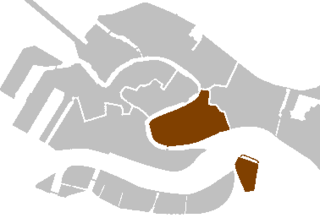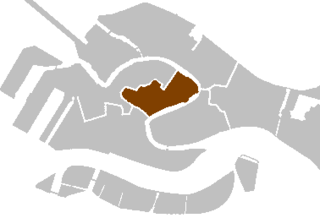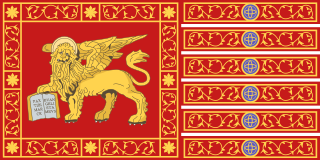
Venice is a city in northeastern Italy and the capital of the Veneto region. It is built on a group of 126 islands that are separated by expanses of open water and by canals; portions of the city are linked by 472 bridges. The islands are in the shallow Venetian Lagoon, an enclosed bay lying between the mouths of the Po and the Piave rivers. In 2020, around 258,685 people resided in greater Venice or the Comune di Venezia, of whom around 51,000 live in the historical island city of Venice and the rest on the mainland (terraferma). Together with the cities of Padua and Treviso, Venice is included in the Padua-Treviso-Venice Metropolitan Area (PATREVE), which is considered a statistical metropolitan area, with a total population of 2.6 million.

Burano is an island in the Venetian Lagoon, northern Italy, near Torcello at the northern end of the lagoon, known for its lace work and brightly coloured homes. The primary economy is tourism.

Cannaregio is the northernmost of the six historic sestieri (districts) of Venice. It is the second largest sestiere by land area and the largest by population, with 13,169 people as of 2007.

A comune is an administrative division of Italy, roughly equivalent to a township or municipality. It is the third-level administrative division of Italy, after regions and provinces. The comune can also have the [[City status in Italy|title of città]].

Bassano del Grappa is a city and comune, in the Vicenza province, in the region of Veneto, in northern Italy. It bounds the communes of Cassola, Marostica, Solagna, Pove del Grappa, Romano d'Ezzelino, Campolongo sul Brenta, Conco, Rosà, Cartigliano and Nove. Some neighbourhoods of these communes have become in practice a part of the urban area of Bassano, so that the population of the whole conurbation totals around 70,000 people.
The name Candia can refer to:

San Marco is one of the six sestieri of Venice, lying in the heart of the city as the main place of Venice. San Marco also includes the island of San Giorgio Maggiore. Although the district includes Saint Mark's Square, that was never administered as part of the sestiere.

San Polo is the smallest and most central of the six sestieri of Venice, northern Italy, covering 86 acres (35 hectares) along the Grand Canal. It is one of the oldest parts of the city, having been settled before the ninth century, when it and San Marco formed part of the Realtine Islands. The sestiere is named for the Church of San Polo.
A frazione is a type of subdivision of a comune (municipality) in Italy, often a small village or hamlet outside the main town. Most frazioni were created during the Fascist era (1922–1943) as a way to consolidate territorial subdivisions in the country.

The city of Rome, Italy, is divided into first-level administrative subdivisions.
A terziere is a subdivision of several towns in Italy. The word derives from terzo ("third") and is thus used only for towns divided into three neighborhoods. Terzieri are most commonly found in Umbria, for example in Trevi, Spello, Narni and Città della Pieve; towns divided into terzieri in other regions include Lucca in Tuscany, and Ancona and Macerata in the Marches. The medieval Lordship of Negroponte, on the island of Euboea, was also divided into three distinct rulerships, which were known as terzieri.
A quartiere is a territorial subdivision of certain Italian towns. The word derives from quarto ("fourth") and was thus properly used only for towns divided into four neighborhoods by the two main roads. It has been later used as a synonymous of neighbourhood, and an Italian town can be now subdivided into a larger number of quartieri. The Swiss town of Lugano is also subdivided into quarters.

A rione of Rome is a traditional administrative division of the city of Rome. Rione is an Italian term used since the 14th century to name a district of a town. The term was born in Rome, originating from the administrative divisions of the city. The word comes from the Latin word regio, meaning "region"; during the Middle Ages the Latin word became rejones, from which rione comes. Currently, all the rioni are located in Municipio I of Rome.
A rione is a neighbourhood in several Italian cities. A rione is a territorial subdivision. The larger administrative subdivisions in Rome are the municipi, with the rioni being used only in the historic centre. The word derives from the Latin regiones, the 14 subdivisions of Rome imposed by Augustus. The term has been adopted as a synonym of quartiere in the Italian comuni.
Circoscrizione can refer to two different administrative units of Italy. One is an electoral district approximating to the English constituency, but typically the size of a province or region, depending on the election. The other is a subdivision of city comuni, roughly equivalent to the municipal arrondissements of Paris or the London boroughs.
Rosà is a town of 14.328 inhabitants in the province of Vicenza, Veneto, Italy. The name comes from the Latin word "roxata", the ancient name of the biggest irrigation channel that passed in that area. The municipality has got 4 hamlets. Rosà is officially European Town of Sport 2011.

Vicaria, often known as Il Vasto, is one of the 30 quartieri of Naples, southern Italy, lying immediately to the east of the historical city centre.

Castello is the largest of the six sestieri of Venice, Italy.

The Triarchy of Negroponte was a crusader state established on the island of Euboea after the partition of the Byzantine Empire following the Fourth Crusade. Partitioned into three baronies run by a few interrelated Lombard families, the island soon fell under the influence of the Republic of Venice. From circa 1390, the island became a regular Venetian colony as the Realm of Negroponte.

The Realm or Kingdom of Candia or Duchy of Candia was the official name of Crete during the island's period as an overseas colony of the Republic of Venice, from the initial Venetian conquest in 1205–1212 to its fall to the Ottoman Empire during the Cretan War (1645–1669). The island was at the time and up to the early modern era commonly known as Candia after its capital, Candia or Chandax. In modern Greek historiography, the period is known as the Venetocracy.












